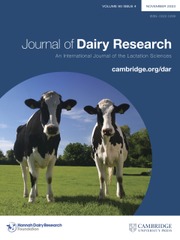No CrossRef data available.
Article contents
Kinetics of local and systemic immune cell populations in Staphylococcus aureus chronically infected bovine mammary gland during active involution
Published online by Cambridge University Press: 15 October 2025
Abstract
The aim of this study was to evaluate the kinetics of local and systemic immune cell populations in mammary secretions and blood samples from cows free of intramammary infections (IMI) and chronically infected with Staphylococcus aureus during active involution. Cows in late lactation that were either uninfected or with chronic S. aureus IMI were included in this study. The percentages of CD14+ cells in blood samples were significantly higher in S. aureus-infected animals than in uninfected animals at days 7 and 21 post-drying-off. However, the percentages of these cells in the mammary secretions from S. aureus-infected quarters were significantly lower compared with those of the uninfected quarters in all evaluated periods. The percentages of CD4+ cells were similar between uninfected animals and S. aureus-infected animals at all involution times in both blood and mammary secretion samples. The percentages of CD8+ cells decreased significantly in mammary secretions of S. aureus-infected quarters compared with those of the uninfected quarters at all involution stages. The percentages of CD21+ cells decreased in blood samples of S. aureus-infected animals compared with uninfected animals at day 21. In secretion samples, the percentages of CD21+ cells decreased in S. aureus-infected quarters at day 7 compared with those of the uninfected quarters. In conclusion, chronic S. aureus IMI induces a significant increase in the number of CD14+ cells in the blood circulation; however, these cells do not appear to migrate to the mammary secretion being potentially retained in the tissue. Although CD4+ and CD8+ lymphocytes did not vary between S. aureus-infected and uninfected animals throughout involution, the decrease in CD8+ cells in mammary secretion from S. aureus-infected animals suggests that these cells are retained in the mammary tissue, fulfilling their specific functions to eliminate intracellularly infected cells. The low number of CD21+ lymphocytes in mammary secretions of infected animals would reduce the humoral defence potential of the gland.
Keywords
Information
- Type
- Research Article
- Information
- Copyright
- © The Author(s), 2025. Published by Cambridge University Press on behalf of Hannah Dairy Research Foundation.
Footnotes
These authors contributed equally to this work.

